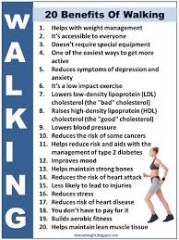WALKCERCISE THERAPY
(walking exercise)
BURHANI NATURAL SCIENCE
Walk for a healthy body
Walking is one of the easiest ways to stay fit. You may have a busy life, but try and introduce physical activity in your life. A moderate dose of physical exercise for 30 minutes (if you can’t manage that much, even 15 minutes is okay to begin with) a day is enough to keep you healthy.
This form of aerobic fitness can lift your mood, make you physically fit, and improve the quality of your life.
Before you start
Wear the right pair of walking shoes and comfortable clothes. Also remember to carry and drink water while you walk, to hydrate yourself. Walk for 15-20 minutes for the first three days, and then gradually increase the time. You can use a pedometer to count the steps you take.
**Walk your way to a healthy heart
Walking can lower your cholesterol levels and decrease the risks for cardiovascular diseases. It can also strengthen your heart, muscles and lungs. A strong heart with an increased heart rate is able to carry more blood to the rest of your body.
**Brisk walking every day lets you
burn up to 200 calories and reduces body fat.
**Cuts your risk of hypertension and diabetes
**According to a study, regular walking improves the BMI (body mass index) and blood pressure levels in people with diabetes. Allowing muscle movement leads to more use of glucose by the muscle cells. This also involves utilization of more insulin, which improves blood sugar levels. Low blood pressure levels can also protect against kidney failure, heart attack and stroke.
**Reduces risks and effects of cancer
Research shows that in colon cancer, a speedy walk can give less time to the carcinogens present in the food to come in touch with the intestinal lining and reduce the risks of having cancer from the start itself.
With improved blood circulation, walking brings in positive energy within the body and therefore lessens the side effects of chemotherapy.
**Protect against miscarriages
Despite the several body changes during pregnancy, regular walking can benefit you in many ways.
**It can reduce fatigue and related pains, help lose weight easily, and lower risks of gestational diabetes. Walking can also prevent spontaneous abortions by lowering down the hormonal fluctuations which cause uterine contractions.Walk for better sexual health
**A regular habit of brisk walking can improve your performance in bed. Walking two miles a day boosts blood circulation which cuts down on the risk of impotency. You can be healthy and fit, and need not rely on medicines to keep your love life active.
**Rejuvenate your mind and spirit
Walking benefits not just your body but also your mind.
Brisk walking helps ease stress and anxiety, reduces depression and imparts a positive kick-start to your day. It improves your self-esteem, charges up the mood and helps to keep you energetic, positive and happy throughout the day.
Top 10 benefits of walking
And this weekend, if there’s just one thing you should start doing to get fitter, let that be walking. Here are 10 reasons why!
1. It’s great exercise. Walking at a steady pace for 30 to 45 minutes a day has been proven to be an excellent fat burner. Do this six times a week, along with following a healthy diet, and you will see a change in your weight. A good speed of walking is 6km/hour. In other words, it should take you 10 minutes to cover a kilometre.
2. It’s good for the heart. Walking is known to reduceblood pressure, improve blood circulation and all round cardiovascular functions
3. It increases stamina. Walking regularly at a good speed also improves muscle strength and endurance.
4. Promotes mental health. Walking is a great stress buster. And if you’re able to walk outdoors, there’s nothing like it. The combination of fresh air and exercise is an excellent mood booster and you’ll definitely find yourself feeling happier as well as healthier.
5. It’s good for your bones. Walking is a great way of strengthening your bones. Walking 30 minutes a day actually increases bone density and slows down bone loss in the legs. This low-impact exercise also targets your spine, legs and hips.
6. Prevents type 2 diabetes. Studies show that walking 150 minutes per week can reduce the risk of diabetes, which is why doctors highly recommend it to anyone who has a history of diabetes in their family.
7. Reduces risk of breast and colon cancer. Studies show that regular walking can reduce a person’s chances of getting breast and colon cancer.
8. Safer than running. Many experts believe that walking is actually better than running because it’s easier on your knees and joints. It leads to fewer injuries and if you’re just starting to exercise, it’s a good beginner workout.
9. Anyone can do it. Walking is truly a democratic exercise because anyone at ANY fitness level can do it. If you’re completely out of shape, start by walking 20 minutes a day and then slowly increase the time every week.
10. It’s free! Unlike most other forms of exercise, all walking requires is a pair of good walking shoes. Walk in the park; on the road; up the stairs; on a treadmill; in a long corridor, it really doesn’t matter. You don’t need expensive equipment or a partner to do this. So if you’re in the mood for a good, safe workout, just start walking!
HOW TO DO WALKCERCISE
You know you want to begin a fitness program, but don’t know where to start. It’s easy! Walking is one of the easiest and most profitable forms of exercise. All you need is a good pair of shoes, comfortable clothing, and desire.
How to start: First of all, start out slow and easy. Just walk out the door. For most people this means head out the door, walk for 10 minutes, and walk back. That’s it? Yes, that’s it. Do this every day for a week. If this was easy for you, add five minutes to your walks next week (total walking time 25 minutes). Keep adding 5 minutes until you are walking as long as desired.
WATCH your posture. Walk tall. Think of elongating your body. Hold your head up and eyes forward. Your shoulders should be down, back and relaxed. Tighten your abdominal muscles and buttocks and fall into a natural stride.
Be sure to drink plenty of water before, during, and after walking. Incorporate a warm up, cool down and stretches into your routine.
Start your walk at a slow warm up pace, stop and do a few warm up / flexibilty drills. Then walk for the desired length of time. End your walk with the slower cool down pace and stretch well after your walk. Stretching will make you feel great and assist in injury prevention.
The toughest thing about starting a fitness program is developing a habit. Walking daily will help (a minimum of 5 days a week is a good goal). You should walk fast enough to reach your target heart rate, but you should not be gasping for air.
After you have formed the habit you will want to evaluate your program and your goals. Here are some general guidelines:
***If you are walking for the general health benefits try to walk 30 minutes a day, most days of the week, at a “talking” pace. (Talking pace means you have elevated breathing, but you can still carry a conversation.)
***To improve cardiovascular fitness you should walk 3 to 4 days a week, 20 to 30 minutes at a very fast pace. At this pace you are breathing hard but not gasping for air.
***If you are walking for weight loss you should walk a minimum of five days a week, 45 to 60 minutes at a brisk pace.Once you can comfortably walk for 30 to 60 minutes 5 to 6 days a week you may want to put more speed into your routine. Follow these easytips for walking faster (or for some real speed learn to racewalk).Zero to Sixty in Twelve Weeks – An easy to follow schedule to get you walking 60 minutes in 12 weeks.
Notice: If you’re new to walking, start off with slow, short sessions and build your way up gradually. If you have any health concerns or medical conditions, be sure to check with your doctor for advice before you begin a routine.



